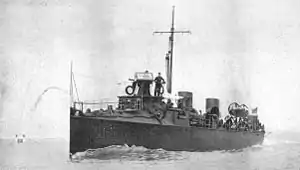Handy-class destroyer
Three Handy-class destroyers served with the Royal Navy. Handy, Hart and Hunter were all built by Fairfield.
 HMS Hunter | |
| Class overview | |
|---|---|
| Name | Handy class |
| Builders | Fairfields, Govan |
| Operators | |
| Preceded by | Banshee class |
| Succeeded by | Sunfish class |
| Built | 1895 |
| In commission | 1895–1914 |
| Completed | 3 |
| Retired | 3 |
| General characteristics | |
| Type | Torpedo boat destroyer |
| Displacement | 275 long tons (279 t) |
| Length | 194 ft (59 m) |
| Propulsion | Thornycroft boilers, 4,000 hp (2,983 kW) |
| Speed | 27 knots (50 km/h; 31 mph) |
| Complement | 53 |
| Armament |
|
Design and construction
As part of the 1893–1894 Naval Estimates, the British Admiralty placed orders for 36 torpedo-boat destroyers, all to be capable of 27 knots (50 km/h; 31 mph), as a follow-on to the six prototype "26-knotters" ordered in the previous 1892–1893 Estimates. Of the 36 destroyers, three ships (Handy, Hart and Hunter) were ordered from Fairfield Shipbuilding and Engineering Company of Govan,[1] the first torpedo craft to be built by that shipyard.[2] As typical for torpedo craft at the time, the Admiralty left detailed design to the builders, laying down only broad requirements.[3][4]
Fairfield's design was 197 feet (60.05 m) long overall and 194 feet (59.13 m) between perpendiculars, with a beam of 19 feet 5 inches (5.92 m) and a draught of 7 feet 6 inches (2.29 m). Displacement was 275 long tons (279 t) light and 310 long tons (310 t) full load,[2] while the ship's complement was 53 officers and men.[5] Three Thornycroft boilers fed steam at 215 pounds per square inch (1,480 kPa) to two 3-cylinder triple expansion steam engines rated at 4,000 indicated horsepower (3,000 kW) and driving two propeller shafts.[2] Two funnels were fitted.[6] Armament consisted of a single QF 12 pounder 12 cwt[lower-alpha 1] gun and three 6-pounder guns, with two 18 inch (450 mm) torpedo tubes.[7] As a gunboat, one of the torpedo tubes could be removed to accommodate a further two six-pounders.[8][9][lower-alpha 2]
In September 1913 the Admiralty re-classed all the surviving 27-knotter destroyers as A Class, although this only applied to Handy herself as the other two ships had already been sold for scrap in 1912.
See also
References
Notes
- "Cwt" is the abbreviation for hundredweight, 12cwt referring to the weight of the gun.
- While many of the 27-knotters later carried both the two torpedo tubes and all 5 six-pounder guns, stability concerns prevented Handy from following suit.[10]
Citations
- Lyon 2001, pp. 19–20.
- Lyon 2001, p. 87.
- Chesneau and Kolesnik 1979, p. 87.
- Manning 1961, p. 39.
- Manning 1961, p. 36.
- Friedman 2009, p. 48.
- Friedman 2009, p. 291.
- Lyon 2001, pp. 98–99.
- Friedman 2009, p. 40.
- Lyon 2003, p. 100.
Bibliography
- Brassey, T.A. (1897). The Naval Annual 1897. Portsmouth, UK: J. Griffin and Co.
- Brown, David K. (2003). Warrior to Dreadnought: Warship Development 1860–1905. London: Caxton Editions. ISBN 1-84067-5292.
- Chan Lau Kit-Ching (1990). China, Britain & Hong Kong 1895–1945. Hong Kong: The Chinese University Press. ISBN 962-201-409-7.
- Chesneau, Roger; Kolesnik, Eugene M, eds. (1979). Conway's All The World's Fighting Ships 1860–1905. London: Conway Maritime Press. ISBN 0-85177-133-5.
- Colledge, J. J.; Warlow, Ben (2006) [1969]. Ships of the Royal Navy: The Complete Record of all Fighting Ships of the Royal Navy (Rev. ed.). London: Chatham Publishing. ISBN 978-1-86176-281-8.
- Crowe, George (1903). The Commission of H.M.S. Terrible: 1898–1902. London: George Newnes.
- Friedman, Norman (2009). British Destroyers: From Earliest Days to the Second World War. Barnsley, UK: Seaforth Publishing. ISBN 978-1-84832-049-9.
- Gardiner, Robert; Gray, Randal, eds. (1985). Conway's All The World's Fighting Ships 1906–1921. London: Conway Maritime Press. ISBN 0-85177-245-5.
- Lyon, David (2001). The First Destroyers. London: Caxton Editions. ISBN 1-84067-3648.
- Manning, T. D. (1961). The British Destroyer. London: Putnam & Co. OCLC 6470051.
- March, Edgar J. (1966). British Destroyers: A History of Development, 1892–1953; Drawn by Admiralty Permission From Official Records & Returns, Ships' Covers & Building Plans. London: Seeley, Service. OCLC 164893555.